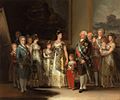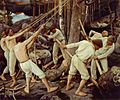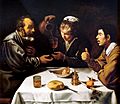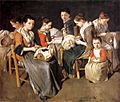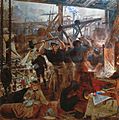Naturalism (arts) facts for kids

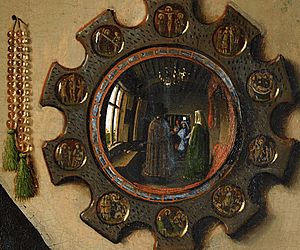
Naturalism in art means showing things exactly as they look in real life. It's about painting or drawing objects and people in a very realistic way. Artists often show them in their natural surroundings. Think of it like taking a super-detailed photograph with paint!
This style became very popular during the Realism art movement in the 1800s. Artists wanted to paint what they saw, not what they imagined or made look perfect. They were reacting against Romanticism, which often showed things in a more dramatic or idealized way.
Many artists throughout history have used a naturalist approach. For example, American artist William Bliss Baker painted amazing, realistic landscapes. French artist Albert Charpin, from the Barbizon School, was known for his detailed paintings of sheep in nature.
This way of painting started way back in the early Renaissance period. It grew even more during that time, especially with artists from the Florentine School. It's all about capturing every tiny, accurate detail.
Contents
What is Naturalism in Art?
Naturalism in art focuses on showing things just as they are. It pays close attention to small details. Artists try to make their work look as real as possible. They want to create a true picture of what they see. This includes showing textures, light, and shadows accurately.
For example, if an artist paints a tree, they will show every leaf and the bark's rough texture. If they paint a person, they will capture their unique features. This style aims for a very honest and precise view of the world.
Naturalism and Realism: What's the Difference?
You might hear the words "naturalism" and "realism" used together. They are very similar! Naturalism is a way of painting that focuses on making things look real. It's about being true to nature.
Realism is an art movement that became popular in the 19th century. Artists in this movement strongly believed in naturalism. They wanted to show everyday life and ordinary people. They avoided making things look too perfect or fancy. So, naturalism is a style, and Realism was a movement that used this style a lot.
A Look Back: Naturalism Through History
Even though the Realism movement was in the 1800s, naturalism has been around for a long time. It started to become important in the early Renaissance (around the 14th century). Artists like those from the Florentine School began to study the human body and nature more closely. They wanted their paintings to look more lifelike.
Over the centuries, many painters used naturalistic techniques. They learned how to create the illusion of depth and reality on a flat surface. This helped art become more and more realistic over time.
Famous Naturalist Artists
Many artists are known for their naturalistic work.
- William Bliss Baker was an American artist. He is famous for his detailed landscape paintings. His works truly capture the look of nature.
- Albert Charpin was a French painter. He belonged to the Barbizon School, a group of artists who painted landscapes. Charpin often painted sheep in their natural settings, showing them very realistically.
- Gustave Courbet was a leading artist of the Realism movement. His paintings, like Bonjour, Monsieur Courbet, show everyday scenes with great detail.
- Jan van Eyck was an early Renaissance painter. His work, like the Arnolfini Portrait, shows incredible detail. He made objects look very real, even tiny reflections in a mirror.
These artists, and many others, helped shape how we see naturalism in art. They showed the beauty of the world just as it is.
Images for kids
-
Lord Leighton's Cimabue's Celebrated Madonna of 1853–55 is at the end of a long tradition of illusionism in painting, but is not Realist in the sense of Courbet's work of the same period.
-
Bas-de-page of the Baptism of Christ, "Hand G" (Jan van Eyck?), Turin-Milan Hours. An advanced illusionistic work for c. 1425, with the dove of the Holy Ghost in the sky.
-
William Bliss Baker, American Naturalist painter, Fallen Monarchs, 1886
-
Pekka Halonen, Finnish Naturalist, Pioneers in Karelia, 1900
-
Diego Velázquez, The Farmers' Lunch, c. 1620
-
Giacomo Ceruti, Women Working on Pillow Lace, 1720s
-
Jean-Baptiste-Siméon Chardin, Woman Cleaning Turnips, c. 1738, Alte Pinakothek.
-
Jean-Baptiste Greuze, The Laundress, 1761
-
Albert Edelfelt, The Luxembourg Gardens. 1887
-
Gustave Courbet, The Stone Breakers, 1849
-
Jean-François Millet, The Gleaners, 1857
-
Honoré Daumier, The Chess Players, 1863
-
Jean-Baptiste-Camille Corot, Young Girl Reading, 1868
-
Jules Bastien-Lepage, October, 1878, National Gallery of Victoria
-
Ilya Repin, Religious Procession in Kursk Province, 1880–1883
See also
 In Spanish: Realismo artístico para niños
In Spanish: Realismo artístico para niños


